LOCAL DELICACIES
- Avgolemoni: Chicken, lemon, egg and rice soup. A classic local delicacy.

- Bourekia: Pastries with Fresh Anari Cheese

- Chiromeri: Smoked, marinated and pressed pork. Delicious with koulouri
- Cyprus coffee & Coffee shop: Cypriots drink a lot of local coffee. It is made individually in long handled pots, wide at the base and tapering at the top. These are called mbrikia, and come in various sizes. Fresh coffee beans, usually Brazilian, are finely ground, and one heaped teaspoon is added to each demitasse of cold water. Sugar goes in too at this stage, before heating the coffee on the stove. Therefore you need to know whether you order your coffee 'glykos' (sweet) 'metrios' (medium sweet), or 'sketos' (unsweetened). The mbrikia are heated on the stove and when the sugar has dissolved, the coffee is allowed to come to the boil, forming a creamy froth 'kaimaki' on top. As the froth turns in from the sides, and the coffee begins to rise in the pot, it is removed from the heat and a little is poured into each cup, to distribute the froth. Cyprus coffee is strong and should always be served with a glass of cold water. Sip with care for at the bottom of every cup lurks a little sediment - don't drink it




- Cyprus Delight Just east of Paphos is the village of Geroskipou, with its cluster of little basket and gift shops strung along the roadside. It is a place well worth exploring with the picturesque five-domed Byzantine church of Ayia Paraskevi and newly renovated Folk Art Museum.
The village's history stretches back to ancient times; its name, comes from the classical Greek "Heiros Kipos" meaning "Sacred garden" it is believed that it used to be an extensive area of beautiful gardens, filled with fragrant flowers and pomegranate trees, dedicated to the goddess Aphrodite. Pilgrims would rest in the gardens on their journey to the sacred temple at Kouklia from the old harbour at Paphos. Today the gardens have long since gone. But the village is still filled with a sweet sugary fragrance that is carried on the air from a cluster of small buildings where the famous "Cyprus Delights" (a euphemism increasingly used since 1974 to describe what is called Turkish delight in English) are made (in Greek, their name, Loukoumia, has no geographical connotations).
Roadside stalls are piled high with brightly coloured boxes of these delicious sweets and the owners stand in the shop doorway and warmly invite you inside to watch the sweets being made. Cyprus Delights have been made in the village since 1895 and the little factories are all family concerns that have been handed down through the generations.
Each family closely guards their secret recipe.

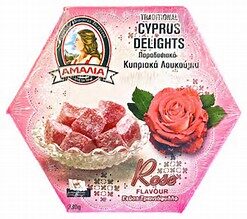

- Cyprus Sweets:
- Karydaki - Vazanaki - Karpouzi - Kolokithaki - Amigdalou - Kitromilo - Milo - Axladi -Kerasi - Mosfilo
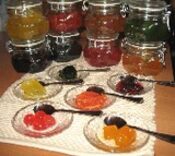
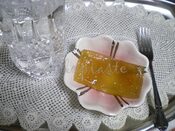

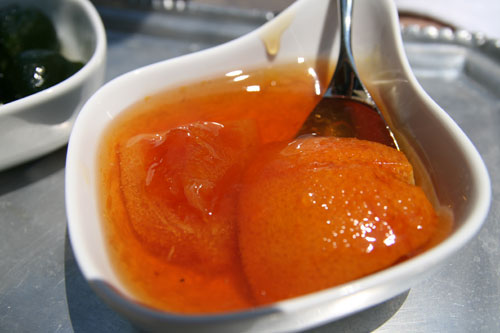
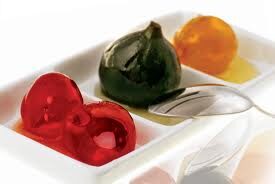
- Karydaki : Fresh Walnuts In Syrup. Among all the traditional spoon sweets this can be ranked on the top of the list as the best.
- Vazanaki : Eggplant spoon sweet.
- Karpouzi: Watermelon spoon sweet
- Kolokithaki: Courgette spoon sweet
- Amigdalou: Almond spoon sweet
- Kitromilo : Orange peel spoon sweet
- Milo: Apple spoon sweet
- Axladi : Pear spoon sweet
- Kerasi : Cherry spoon sweet
- Mosfilo: A sweet made from a small orange berry
- Daktyla: Daktyla kyrion (meaning ladies fingers) is one of the best known Cypriot pastry desserts (filled with ground almonds and cinnamon sugar) and a speciality offered during the pre-Lenten period called «

Sikoses» in Cyprus. The word «sikoses» derives from the verb 'sikono', meaning lifting. Sikoses is the ten day period before lent when no meat is eaten. Like most of the Cypriot traditional recipes, these were made with simple ingredients which the housewives had at home everyday. A very old recipe with few ingredients but so delicious.
- Eliopitta: Ellioti Olive pies are particularly popular in Cyprus, they are delicious and constitute a great healthy snack.
- Fasolia: Beans. Sometimes cooked with potatoes, carrots, celery and tomatoes and sometimes with Swiss chard.
- Flaounes: Traditional Easter bread. Eggs, cheese, sultanas and sugar stuffed in a kind of pastry and oven baked.
- Halloumi Up to now the women of the village made the traditional cheese of Cyprus, “halloumi” (made of goat and sheep’s milk) . Unfortunately young people don’t seem willing to continue the tradition, which will probably be lost in the future. However Halloumi is now made commercially.
How Halloumi is made. Firstly, the milk is heated at a low temperature inside a “chartzi” (traditional large copper caldron). Thereafter, the producer adds “pithkia” which is a special powder/enzyme that thickens the milk. An hour later, the milk is set and then the halloumi is cut and put in the “talaria” (special wicker-baskets). Later on, the halloumi is pressed by hand so that all the liquids are removed.
After the “pressing”, it is placed in the“tiroskamni” (traditional tool) and it is cut into pieces (approximately 200gr each). The rest of the liquid, which remained in the caldron, is reheated at a high temperature thus producing “anari” (white soft cheese).
The halloumi pieces are then placed back into the caldron, inside the“norros” (whey), and are heated over a low flame until they are completely cooked. The cooking procedure lasts for about 60 to 90 minutes during which the small pieces of halloumi must be occasionally stirred with a special dipper. After being cooked they are again placed in the “tiroskamni” (cheese maker’s tool) to cool down. Afterwards they are salted and various aromatic elements (such as mint) are added. When the halloumi is cold, placed into plastic or glass vessels with “noro”.
The halloumi and the anari are white in colour, unlike the majority of other cheeses.

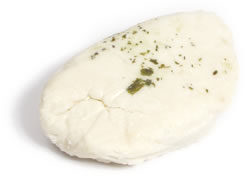
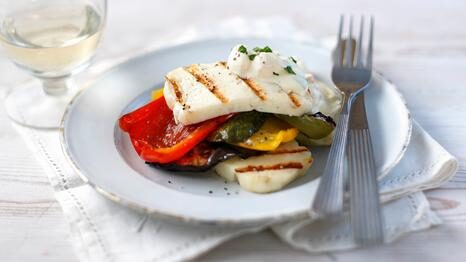
- Halva: Sesame seeds pulp and sugar melded into a square, sometimes with nuts or vanilla flavouring.
- Hiromeri: Similar to Parma ham, delicious thinly sliced. Cured with wine and spices.
- Kattimeri: Kattimeri is a Cyprus dessert which comes from an old traditional recipe. A bread type dough, which is spread with sugar, oil and cinnamon, before being folded like an envelope and cooked on a special griddle. Serve with honey.
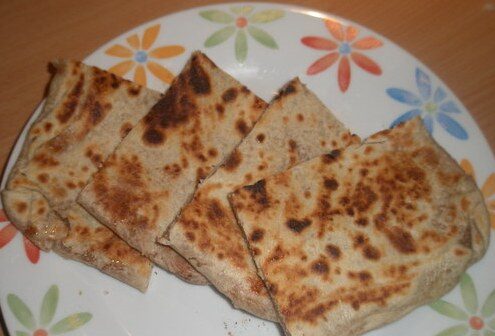
- Kefalotyri: Hard rinded cheese which comes in large rounds. Good texture and quite strong in flavour.
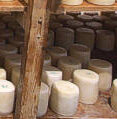

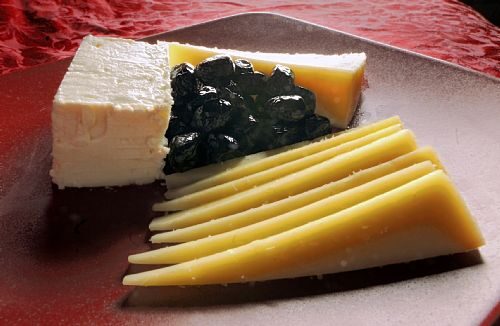
- Kleftiko: This is a dish of slow baked lamb, which is cooked in a sealed oven in the garden. By using this method of cooking the meat cooks completely in its own juices and tastes delicious. The dish got its name from the word 'kleftis' which means robber, and it is said that in the past, mountain men would cook their stolen meat in sealed underground ovens.

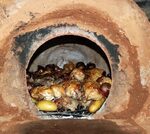
- Kolokasi: A delicious vegetable that resembles a Swede/turnip/parsnip/ sweet potato type of root vegetable. It has a magnificent texture and has a fascinating taste. You cannot cut it with a knife when preparing it as it becomes slimy, so you have to break it into pieces before cooking. It is often served with a tomato sauce and is well worth trying.

- Kolokoti: A pastry triangle stuffed with red pumpkin, cracked wheat and raisins
- Koulouri: Delicious small white loaf, smothered with sesame seeds, and sometimes some caraway or anise. Comes in ring shapes or easily dividable oblongs.
- Koumantaria: An amber-coloured sweet dessert wine made in the Commandaria region of Cyprus on the foothills of the Troodos mountains. Commandaria is made from sun-dried grapes of the varieties Xynisteri and Mavro.
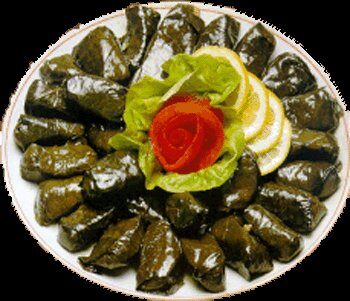
- Koupepia: These are rolled vine leaves stuffed with meat and rice, especially good when prepared with the spring leaves of young vines.
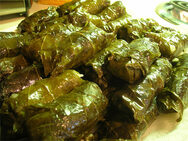
- Koupes: Cigar shaped savouries, containing meat, onions and parsley surrounded in a thin, crispy layer of crushed bulgar wheat. Eat with a wedge of lemon that you squeeze into the top.
- Kritharaki /Youvetsi: Kritharaki, orzo or rice-shaped pasta is used in Cypriot cookery to make Youvetsi where it is cooked in the oven absorbing the flavour of the lamb and sauce ingredients. It also makes tasty pasta meal base when boiled with sauce ingredients. Alternatively, try Kritharaki or Orzo pasta as an alternative to rice.
- Lachana: A spinach type leaf, but with a thicker white stalk. Often cooked with black eyed beans in a kind of stew.
- Local Fruits & Vegetables: Formozes, Mosfila


- Loukanika Krasata: Cyprus Sausages Loukanika is the Greek word for pork sausage, usually somewhat dried. There are a variety of sausages, but perhaps the best known is flavoured with fennel seeds and orange peel. Loukanika is often served at a mezze, sliced and fried. It is also used in the cooking of a variety of dishes .


- Lountza Loin of pork, smoked and marinated. Delicious with koulouri. Buy from a delicatessen.
- Makaronia tou Fournou: Pastitsio: A baked dish, rather like macaroni cheese with a layer of spiced meat in the middle and white sauce on top.
- Mezedhes: Meze for short, or little delicacies, appear in some form or other wherever you travel throughout Cyprus. The Cypriots love to share a meze, and family meals will see the table loaded up with many dishes for everyone to share. Share a meze in Cyprus and you have tasted the true flavours of the island, for you may be served up to 30 dishes. It is a complete meal, but beware, don't be tempted to finish every dish that arrives on the table, or you may feel as though you've eaten for a week by the end! Do as the Cypriot's do and enjoy your meze, 'siga siga' or slowly, slowly. Firstly you will be served olives, with a dressing of lemon, garlic, herbs, coriander seeds and oil. After that dips such as tahini, skordalia, taramasalata and tzantziki will arrive with a basket of fresh village bread and a bowl of village salad. Some more unusual meze dishes would include 'octapodi krasato' - octopus in red wine, 'zalatina' - brawn and pickled capers or cauliflower. Vegetables tossed in oil and bound with egg are often served at this next stage.







Some kind of fish will often be served next, such as 'kalamari', which is rings of squid , battered and deep fried. Grilled 'halloumi' cheese and 'lountza' - smoked pork, come next, followed by 'keftede' - meatballs , the popular 'seftalia' - grilled pork rissoles and 'loukanika' - the smoked Cyprus sausage.
Once you have eaten all of this, dishes such as 'afelia' - pork cooked in red wine and crushed coriander seeds, moussaka - layers of aubergines or courgettes, potatoes, minced meat and white sauce and 'stifado' - beef stew with onions will be served. Towards the end of the meal come the kebabs or 'souvlakia', the kleftico' - baked lamb from the oven and grilled chicken. You have now eaten most of your meze, but fresh fruit and perhaps a few sugar dredged 'bourekia' - pastry filled with soft cheese or honey will complete your meal!
- Mouchendra: Lentils, rice and fried onions.
- Moussaka: Oven cooked dish with layers of potatoes, aubergine, meat and white sauce.
- Olive Oil: Olive oil is believed to be responsible for the good health and longevity of the people who consume it for organic oil visit www.oliveoilcy.com
- Pacha: Sheep's brain soup. Sometimes including the bonus of the skull! Prized locally especially in the villages.
- Pastellaki: A nut brittle made from carob honey.
- Palouzes and Soutzoukos, the palouzes and the soutzoukos
- are two of the most popular sweets of Cyprus. You will usually find them in villages that produce grapes.
Preparation: The process of making soutzoukos involves two basic steps. The first step is to make the must jelly. First, must is extracted from good quality grapes. As soon as the must is extracted, it is placed in a large bronze container (called chartzin or kazani) which resemble a big cauldron. The must is then heated slowly. A special kind of white soil, called asproi is then added to the boiling must to assist in the removal of impurities from the must. A very small amount of asproi is added in the boiling must, causing the impurities to rise on the surface where they are collected and removed. Once the cleansing process is complete the must is left to cool down. Next, the flour is added to the must while stirring and heating the mixture. When the mixture gets to the right consistency, judging by the rate of steam bubbles and the fluidity of the mixture, it is removed from the heat. The mix, called palouzes, is now ready for dipping the almond strings and make soutzoukos.
The next step is the making of soutzoukos involves the creation of strings almonds (or walnuts)tn which are dipped palouzes mixture and are then left to dry. Firstly, the nuts are shelled and dipped into water in order to become softer. Once soft enough they are strung using threads of about 2-3 metres length. The strings are dipped in the palouzes mixture until completely covered. This process is repeated several times (usually three times) until soutzoukos has the desired thickness. Soutzoukos strings are then left to dry for 5-6 days. They are then ready for consumption or storage, even though some people like to eat soutzoukos fresh.



- Pastourma: A very spicy meat full of garlic and coriander. Made from beef.
- Paphitiki Pissa: A chewing gum made in Paphos
- Pitta: Unleavened bread, oval shaped and flat. Warm it on a grill and it puffs up ready for a kebab to be inserted.
- Pourgouri: Cracked wheat is steamed together with some fried onions and chicken stock to make a light and fluffy pilaf which is always served with yogurt.
- Psito: Roasted meat with potatoes
- Psoumi: Round flattened loaf, (large and small) of heavier bread. Delicious when fresh, OK when a day old, best toasted when 2 days old.
- Resi The “resi” was actually wheat. Young women (accompanied with violins )usually prepared this food. They carried it to the old taps of the village and cleaned it on the day before a wedding, as it was one of the main wedding dishes.
It is actually a pilaf of lamb and coarse wheat cooked in the broth of chicken, pork and beef. The pieces of lamb were put in large cauldrons and they were braised on a low heat. Later on, the coarse wheat was added. When the food was ready, it was served to the guests. It was very popular in Limassol and Paphos.

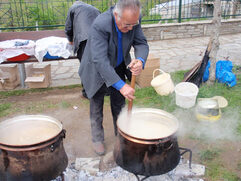
- Souvla: Souvla is a popular dish from the island of Cyprus. It consists of large pieces of meat cooked on a long skewer over a charcoal barbecue.
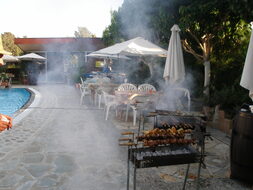

- Souvlakia: Souvlaki or souvlakia is a popular Cypriot fast food consisting of small pieces of meat and sometimes vegetables grilled on a skewer. It may be served on the skewer for eating out of hand, in a pita sandwich with garnishes and sauces, or on a dinner plate, often with fried potatoes. The meat is traditionally lamb in Cyprus, or in modern times increasingly pork due to the lower cost.
-
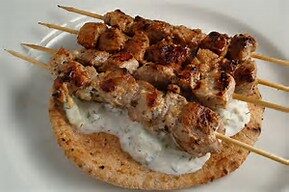

- Stifado: A beef and onion stew that is mildly sweet, sour and spiced

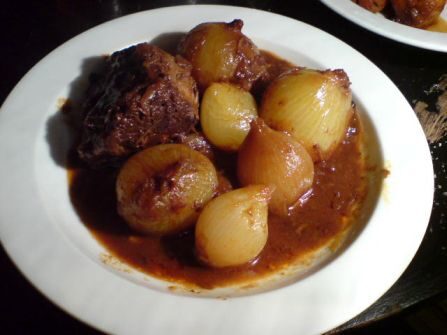
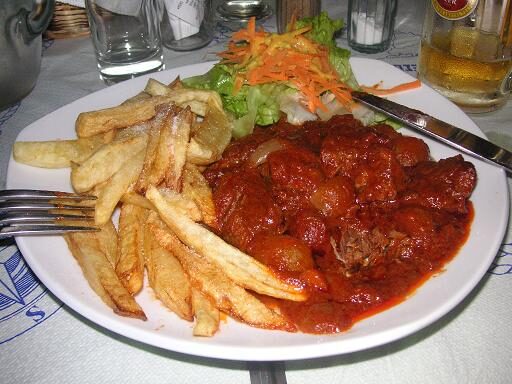
- Tahini: A blend of crushed sesame seed paste, lemon juice, water, garlic and olive oil, sprinkled with parsley.
- Taxinopitta: Taxinopitta is usually made with a cinnamon dough which is then spread with a sweet tahini dip. It is then rolled and twisted into shapes.
- Trachanas soup: The “trachanas” is a very popular soup in Cyprus. It is delicious and very nutritious. Its main ingredients are sour milk and coarse wheat. A brief explanation of how it is made is shown below.
The wheat is washed and then it is ground on a quern. The grinding is done by inverse rotation so that the seeds are shelled and broken. When the procedure is completed, the sour milk is poured in the “chartzin” (large bronze vessel) with the coarse wheat. The mixture is heated and mixed until it becomes thick and creamy. When it cools down, it is cut in balls and put in the “tsestous” (dish made of straw) until it becomes dry. These dried pieces are kept in a cool place and they can be preserved for a very long period.
Every time someone wants to cook trachanas, they take some of these small pieces and soak them in water for some hours. Thereafter, they boil them in broth. While boiling, you can add a little bit of milk or small pieces of halloumi. The trachanas is served hot with salt, pepper and lemon.
In older times this soup was very popular, especially for the cold winter nights. The villagers also used to eat it before they left for work at dawn. It is still the favourite soup of the Cypriots. Nowadays, you can find it in supermarkets.
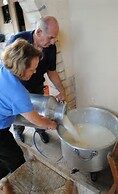


- Tsamarella: Tsamarella is a Cypriot traditional food. It consists of meat, usually goat, that is salted and cured for preservation. The process of preparation traditionally involves drying in the sun
- Tzadziki: A yogurt, cucumber and mint dip that you will find in most restaurants served with tahini, olives and salad.

- Zalatina: The name is probably derived from the word gelatine. This dish is usually made with pork’s head, ears and feet. but some lean meat can be added. The head, feet and tail are cleaned and any hair on them is scorched and shaved if necessary. All these are boiled with spices until tender and then citrus juice and vinegar, salt and some hot red peppers and rosemary are also added. After cooking all the meat from the head is removed and is put in earthen pots together with the broth, which forms into a jelly because of the pectin created from the animal parts and from the citrus A thick layer of lard forms on top, thus sealing it and thus preserving it for a long time.
- Zivania - The Drink from Cyprus Zivania is a traditional Cypriot drink known as the local firewater spirit, that is made in the mountains from Cyprus. It is a distilled clear drink produced from the residue of grapes that were pressed during the wine making process and mixed with dry wines produced from the local grape varieties of Cyprus. It is also, a 70% proof alcoholic drink that will burn the back of your throat once you have drunk it. It is best to just knock it back straight if you are drinking it without anything else added to it. Drinking this it will literally burn your throat, so it is best to drink it very quickly!



The History: Zivania has been produced in Cyprus since the Republic of Venice ruled the island at the end of the 14th century and since 2004, Zivania has been protected under EU regulations as a product unique to Cyprus. Therefore, it cannot be produced in any other country and it is marketed under it's Cypriot name.
How Is It Made? Zivania is made from mature healthy grapes of the best quality. It is produced from pomace, the residue of grapes that were pressed during the wine making process mixed with high-quality dry wines, all produced from the local grape varieties of Cyprus. Zivania is exclusively produced by the distillation of the two indigenous varieties, namely Mavro and Xynisteri. Zivania may also be produced by other, either local or imported varieties, but the variety used must be distinctively indicated on the label, for example as Zivania Cabernet or Zivania Maratheftiko.
What Is It Used For? Other than drinking Zivania, the Cypriots use it for other purposes. It can be used to treat wounds, massaging sore parts of the body, as a remedy for colds, toothaches or as a warming-up drink during winter months. It can, also, be used for mosquito protection and for mosquito bites. Especially, good to drink if you have a sore throat It is drunk morthe villages of the Troodos mountains. In the old times, the main alcoholic drinks that Cypriots drank, were wine and Zivania. Sometimes, cinnamon was added to Zivania giving it a nice red colour and a fine aroma and flavour. As Zivania ages, it becomes better and maromatic. Aged Zivania was valued very highly and was kept for consumption during special occasions or as a treat for visitors. Even nowadays, in some Cypriot villages, visitors will be welcomed to a home with Zivania, served together with almonds, walnuts, loukoumi, soutzoukos or small appetisers loukaniko or lountza.
Zivania is best served ice-cold with a local meze, soutzoukos or dried fruits and nuts.



